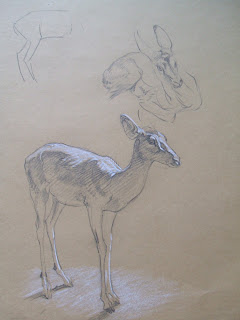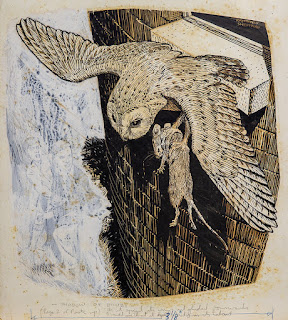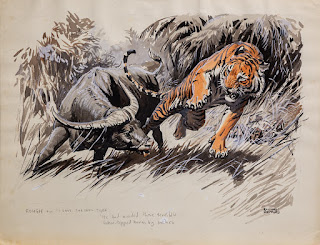 |
| Angling Times 10 July 1953 p11 "Harry Hill's 37lb.Tope at Sowley Beach, Hampshire" |
Every December I search for anything that connects with Christmas but I'm trying too hard so this time I'm presenting a new Raymond Sheppard find I don't think even his family know about. I'm sure Christine will correct me if I'm wrong. I always love hearing how fellow researchers find new information on their obsessions so let me start by saying, I found this thread as a result of a simple search on British Newspapers Archive. I have trawled it many times for Raymond Sheppard and mainly it includes adverts with his name for books. At least that gives us rough publication dates for books he illustrated.
But in this case I was amazed to see mention in the Lincolnshire newspaper Boston Guardian.
 |
| Boston Guardian 2 September 1953 |
So now I knew when and where to look to see if I had discovered a new stream (I can't help myself) of information in the Angling Times! The newspaper/magazine started on Friday 10 July 1953 and was founded by Bernard Venables, Howard Marshall and PR Winfrey and the Editor was Colin Wilcock. Was the name of the editorial office just coincidence - 8, Bream Buildings, Chancery Lane, London EC4
 |
| AnglingTimes 14 August 1953, p11 "Mr. Pitcher's 3lb 3oz. rudd from the River Thurne, Norfolk" |
Venables is famous for being a name associated with angling since 1947 after his post-war comic strip "Mr Crabtree" in Daily Mirror became a very popular strip - turned into a book in 1949. Two million copies sold over the years. Howard Marshall, a broadcaster poached (sorry!) him to found the Angling Times which began with a sales of 30,000 in the first year and grew to 170,000 in 1962. Before he worked on Angling Times, he had already published "Fish and Fishing", "Fisherman's Testament", and the aforementioned "Mr. Crabtree Goes Fishing''. As it states in the first issue:
"Venables early felt almost equal desires to be artist, naturalist and writer. Regularly exhibits at the Royal Academy, is 46, married, has one son Julian, who bears a remarkable resemblance, to Mr. Cherry's friend Jim."
Colin Wilcock, Editor of the "Angling Times," was formerly editor of "Lilliput." and joint, assistant editor of "Picture Post." Writes short stories, radio, two boys' fishing books just published, "Come Fishing With Me," and "Come Fly-fishing With Me." Lives at Walton-on-Thames, is married, aged 34. has son aged four and a half who has caught his first roach, says he likes fishing for gudgeon as much as salmon. Sets up own specimens.
Howard Marshall: Though Personnel and Welfare Officer to one of the largest engineering firms in the country, Howard Marshall is thought of first as a broadcaster. His Coronation commentary from the Abbey will live long in memory. This paper is very much MarshaII's brain-child. A first rate angler, he has long dreamed of foundling a national angling weekly. Once joined expensive chalk stream club to fish for roach.
John "Tiny" Bennett, the photographer is also mentioned like the three above as having "Hobbies: Fishing"!
 |
| AnglingTimes 25 September 1953, p11 "Kenneth Clower's 6.5lb chub from the Hampshire Avon" |
The Angling Times introduces something new in fishing journalism. Once each month, artist Raymond Sheppard will visit the scene of a specimen fish's capture. He will record the battle in a way no camera can do. Be sure to let us know when you think it is your turn for him to visit you.
It didn't quite work out that way, as I have not found any more than those illustrated here. It looks as if 1953 was the only year for which he drew for this magazine. The last strip states "From time to time artist Raymond Sheppard visits the scene of the capture of a big fish [etc.]". Venables' strip "Mr. Cherry and Jim" carries on for some years.
 |
| AnglingTimes 4 December 1953 p15 "H. Brown's 7.5lb Thames Barbel" |
Sheppard also drew some illustrations to accompany short pieces. The first was "Polperro for big shark!" by F. A. Mitchell Hedges, president of the Shark Club of Great Britain.
 |
| AnglingTimes 2 October 1953, p.5 |
 |
| AnglingTimes 2 October 1953, p.5 |
The other one was "Pike - I love the brutes!" by Jack Hargreaves who describes an incident in 1765 at Lillishal Lime Works where a 170lb Pike was caught which several men had to drag out of the water!
 |
| Angling Times 6 November 1953, p.5 |
 |
| Angling Times 6 November 1953, p.5 |














.jpg)







































